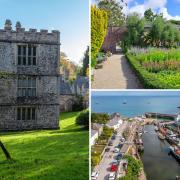Gareth Edwards paintings exhibited at Lemon Street Gallery move from the purely abstract through to the vaguely figurative
EWEN MACDONALD visits Truro's Lemon Street Gallery to review Gareth Edwards
The Gareth Edwards paintings exhibited at Lemon Street Gallery move from the purely abstract through to the vaguely figurative, but most hold a tense ground between each form: not quite altogether in either camp.
One of the abstract variety is Beautiful Torrent is all swishes and slathers leading from a dull grey to vibrant purple. The colours merge and blend throughout the canvas with some strong marks and accents here and there, creating movement, but also a form of transcendent stillness. The torrent and the beauty are in tense equilibrium. The grey and purple juxtaposing and blending to give perspective and depth. Giving the whole pictorial space a feeling that one could simply dive into the painting and disappear into its misty expansiveness.
Turner, of course, seems the natural bedfellow for these paintings and they do certainly connect us to his seascapes. But I also felt there was something reminiscent of the impressionistic touches of Constable in them too. Edwards’ delicate, hazy working of the paint brings to the fore both a luminosity and a depth.
A point in case is the oil on canvas work, Venezia. A gondola in the bottom of the picture just stretching mysteriously out towards us in the blue/white morning light of a city slowly dying and being recaptured by the sea.
Simple timeless images such as the sea can produce and endless array of new and complex images in the hands of the right artist and Edwards knows where to place his marks to give them maximum strength. In Atlantic Front he balances out the density of Anselm Kiefer and the lightness of Turner. The cracks in the oils, the breaks, the fissures, aberrations on close inspection are a nuanced and calligraphic composite from a distance, with the abstract and figurative flowing over in waves.
As I enter the cavernous depths of the gallery my eyes are assailed by The Bay, Morning Light which comes as a shock to the senses as it is so different is taste to the palate of the other paintings being nearly all made up of a whiteness falling to red. The multitude of pinks (an entirely underrated colour) joyously meld into a diaphanous, blue/grey whiteness in the centre of the canvas.
In other paintings, such as Diamond Bay 2015 there is on ample display the dextrous knowledge of the muddy greens and browns of the British headland. This composition pushes us inexorably out towards a turquoise tinged channel and horizon.
In the right corner of Mathematical Progression of a Wave is the scarred, jutting marks that brought to mind the mark making of one of my favourite painters, Nicholas de Stael. The palate knife crisscrossing the canvas, cutting and scoring out mark upon mark. Here and there a small splodge of a lustrous light blue. I love painterly marks, they stand opposed to the pixelated digitised world we now live in. They swoon back to the renaissance and a cultural and artistic landscape that has lasted for hundreds of years.
Paintings are always at there best when the small details can be as admired as the great vista they present. It is a game of two pictorial spaces the particular and the universal. For that tension is art itself. And that art reflects us, because that is what it is to be human, a rendering of lives built up of small details and grand gestures.
Timeless and sublime Gareth Edwards’ has produced images that stalk the mind for a long time after viewing. A true soul cleanser for a dark, wet November morning. Long live painting and may it never die.



























